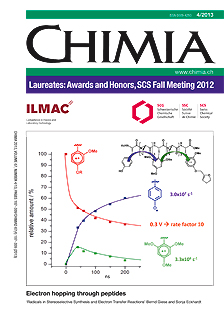Nanopatterning by Molecular Self-assembly on Surfaces
DOI:
https://doi.org/10.2533/chimia.2013.222Keywords:
H-bonding, Self-assembly, Stm, Supramolecular chemistry, SurfacesAbstract
The ability to pattern surfaces down to the nanoscale is of increasing importance in nanoscience research. The use of supramolecular chemistry to drive the formation of self-assembled networks allows for a bottom-up approach to achieve nanopatterned surfaces. This short review highlights some of the recent breakthroughs in achieving long-range order in such molecular based systems, complemented with examples from our own work. The tuning of molecular architectures can exert control on the emergent properties and function of molecules at interfaces. In particular the formation of porous honeycomb networks allows the rational design of highly ordered patterned surface domains and the investigation of molecular dynamics, chirality and templating effects on surfaces.Downloads
Published
2013-04-24
How to Cite
[1]
T. R. Eaton, D. M. Torres, M. Buck, M. Mayor, Chimia 2013, 67, 222, DOI: 10.2533/chimia.2013.222.
Issue
Section
Scientific Articles
License
Copyright (c) 2013 Swiss Chemical Society

This work is licensed under a Creative Commons Attribution-NonCommercial 4.0 International License.







